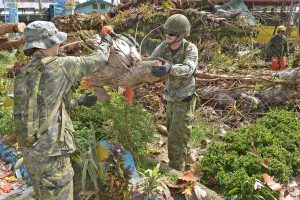Canada deploys to Philippines for Typhoon Haiyan clean up
By Lookout on Nov 25, 2013 with Comments 0

Cpl Brown and a colleague, both DART combat engineers, conduct road tree removal to provide access to Dona Victoria Cortes Dais Memorial School in Pontevedra, Philippines.
With gusts reaching 380 kilometres per hour, Typhoon Haiyan was one of the strongest typhoons ever recorded. Setting off landslides, knocking out power in several provinces and cutting communications in the country’s central region of island provinces, the tropical super storm has affected an estimated 11.3 million people across the Philippines.
It has caused significant loss of life, a large number of injuries and damage to many homes and infrastructure.
In response to the humanitarian situation, Canadian Joint Operations Command implemented Op Renaissance 13-1, deploying more than 300 CAF personnel to provide primary medical care, engineering assistance and safe drinking water.
“One of our primary tasks is to open roads that have been blocked by the effects of the typhoon,” said Task Force Commander, Lieutenant-Colonel Walter Taylor. “We have engineers that are operating heavy equipment as well as chainsaws and electrical experts who will be removing a lot of the rubble that’s blocking the roads and permitting the humanitarian actors, the non-government organizations and the UN agencies, access to those villages to distribute relief supplies.”
The production of potable water is one of the most important contributions of the Disaster Assistance Response Team (DART). The Reverse Osmosis Water Purification Unit is set up and maintained by the Water Production Detachment of the DART Engineer Troop and, under ideal conditions, can purify up to 50,000 litres of safe drinking water a day.
“Agricultural fields, crops have been blown away; storm surge has flooded the fields with sea water; and fishing boats have been destroyed,” said LCol Taylor. “So the people are really at a loss not only for their homes, but for their livelihoods.”
“But the people here are very resilient,” he added. “They’re fighters.”
DART is a multi-disciplinary, self-sufficient, and flexible military capability which can deploy quickly to anywhere in the world. DART acts as a stabilization measure and is deployed upon the request of the affected nation immediately after the emergency phase of a natural disaster. It is meant to bridge the gap until civilian aid organizations can set up shop to provide more long-term assistance.
-Michelle Ferguson, CJOC
Filed Under: Top Stories
About the Author:





